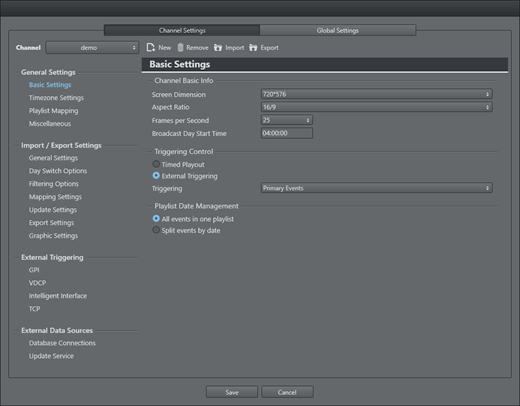
Viz Multichannel
Version 4.0 | Published January 23, 2019 ©
Channel Settings
Viz Multichannel allows you to define Global Settings as well as channel-specific settings that only has an effect on a per channel basis.
The following sections contain reference information on channel specific settings:
General Settings
Import and Export Settings
External Triggering
External triggering is relevant to the control room environment as the protocols involved may be used in the actual broadcast process. Note that for the traffic department, external triggering is (in general) not taken into consideration.
On the right corner of the Settings window, there is an On/Off switch. You can configure settings with the devices on or off. When off, the settings will take effect the next time the device is turned on.
The section contains information on the following topics:
External Data Sources
The section contains information on the following topics:
Channel Basic Info

Format settings are most relevant for Viz Multichannel in master control room (MCR) mode.
-
Screen Dimension: Defines the screen dimension. Options are:
-
SD NTSC: 720 x 486
-
SD PAL/SECAM: 720 x 576
-
HD 720: 1280 x 720
-
HD 1080: 1920 x 1080 (current the default value, user changeable)
-
-
Aspect Ratio: Defines the aspect ratio. Options are 4:3 and 16:9. This setting also affects the aspect ratio of the template editor.
-
Frames per Second: Defines the frame rate at which the output will be displayed. The Media Sequencer may be responsible for the entire playlist or secondary events only (i.e. when an external system controls the primary events). In such situations it is important that this setting is correct, or else the Media Sequencer will not calculate the events correctly creating a frame inaccurate system. See Triggering Control.
-
Broadcast Day Start Time: The broadcast day start time in use for the channel.
Triggering Control

Triggering control is only relevant for Viz Multichannel in master control room (MCR) mode.
-
Timed Playout: Allows the Media Sequencer to control the triggering of the playlist’s timed events.
-
External Triggering: Allows the automation system to trigger the playlist’s timed events.
-
Triggering: Allows you to define the level at which the automation system will have control over the timed events.
-
If the primary events option is selected, the Media Sequencer will trigger the secondary events based on offsets to the timed primary events.
-
If the secondary and video events option is selected, the automation system is in full control of the playlist and the Media Sequencer will act as a slave. Note that this option currently requires video content from Vizrt's Viz One system.
-
Playlist Date Management

-
All events in one playlist: When selected, Viz Multichannel will only allow one continuous playlist exist per channel (recommended). Regardless of time and on-air date, all events are included in the imported playlist.
-
Split events by date: Schedules received from automation systems are split by date. This means that Viz Multichannel usually gets one long sequence of events that may belong to multiple playlists, typically for the current and the next day. Selecting this option causes Viz Multichannel to separate the events based on date and begin time, according to the Broadcast Day Start Time settings.
Note: The Split events by date option is only valid when reading the schedule’s date from within the source file contents (and not the file name). If the filedate field is mapped to read values from filename (= $Filename), this feature will not work.
Timezone Settings
Timezone

-
Channel Timezone: Defines the timezone of the area the channel is being broadcasted into. Options are: -12:00 to +14:00.
-
Schedule Timezone: Defines the timezone of the schedule being imported.
DST Setting

-
Channel is in DST timezone: Check this option when you want to enable the Day-light saving function and select one of the Day-light saving modes:
Dynamic DST Setting

-
Period Start Date: Specifies the date that starts the Day-light saving period.
-
Period Start Time: Specifies the time that starts the Day-light saving period.
-
Period End Date: Specifies the date that ends the Day-light saving period.
-
Period End Time: Specifies the time in local non- DST time that ends the Day-light saving period.
Note: Invert months for southern hemisphere settings.
Explicitly Defined DST Setting

Note: For nations with special DST handling. Press the calendar icon to selected dates from a popup.
-
Period Start Date: Specifies the date that starts the Day-light saving period
-
Period Start Time: Specifies the time that starts the Day-light saving period
-
Period End Date: Specifies the date that ends the Day-light saving period
-
Period End Time: Specifies the time in local non-DST time that ends the Day-light saving period
Playlist Mapping
The playlist mappings define how the current playlist (rundown) columns are mapped to attributes.
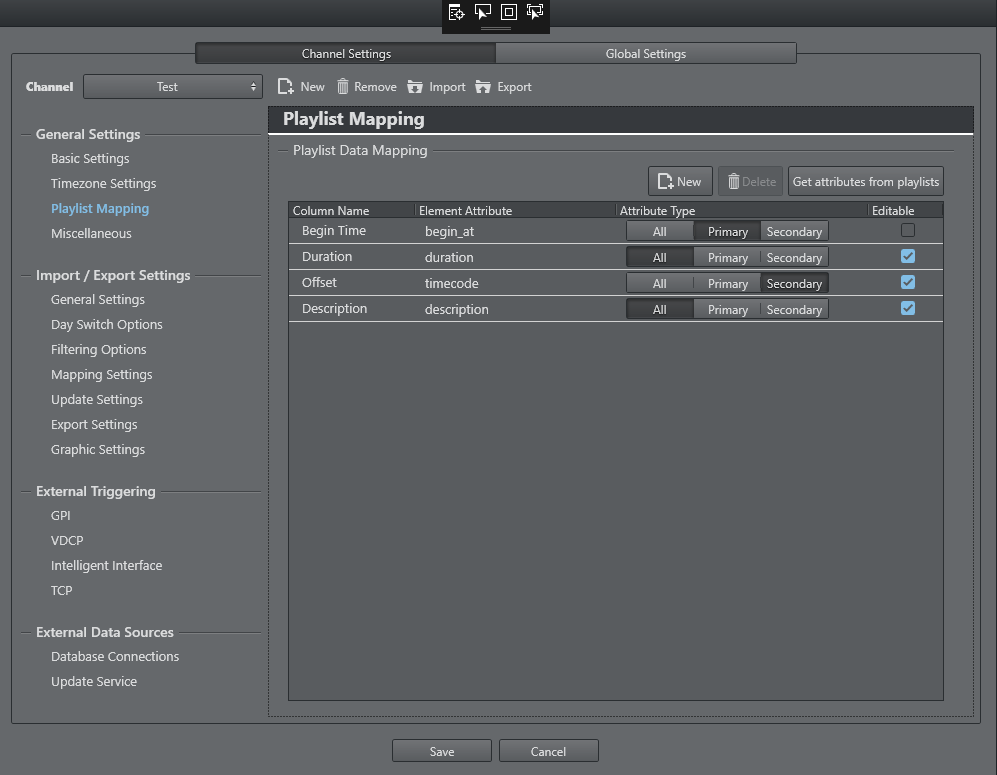
-
Column name: Specify what attribute name will be shown on the playlist.
-
Element Attribute: All attributes in the Element Attribute column are used in Page Content Filling Dialog, Rules condition and Filtering Options in Import/Export Settings.
-
Attribute Type: Indicates whether an attribute belongs to primary event, secondary event or both.
-
Get attributes from playlist: Examine attributes from all playlists in the channel and find all attributes in primary and secondary events. Automatically adds all attributes in the Playlist Data Mapping table with a blank Column Name. If you want to show this attribute in the playlist column (option Use External Data menu when right-clicking on playlist column), you have to first fill in a Column Name
Miscellaneous
Playlist Options
-
Expand running primary element: If set to true the playing primary element will be expanded when it is started (triggered).
-
Lock view to running primary element: if enabled, this option will scroll the view of the playlist to the current running group (i.e. primary element) to the top whenever the primary element is changed.

General Playout Options
-
Allow item replay: When checked the automation system requests the replay of an item in a playlist (same Media ID), Viz Multichannel will go back and play the requested item (even if marked as played). When unchecked, it prevents an event from being played twice, but looks for the next event with the requested ID marked as not played.
Note: If you are using duplicate Media IDs, uncheck this option.
Edit Options

-
Clear ID after editing secondary event: When checked the secondary event ID is removed from the edited element in the playlist. This allows you to receive an updated schedule without overwriting already edited secondary events in your playlist.
Scene Import

-
Report DVE errors during import: When checked, if in the Basic Settings you selected to Play Video Through the Viz Engine, any Viz Artist scenes being imported as Viz Multichannel templates that were built without DVE support will be reported. Therefore, if you selected to play video through the Viz Engine, it is recommended that you select this option, as DVE support is important. If you do not play video through the Viz Engine, you can leave this setting unchecked, or if you do not wish to see this error highlighted.
Playlist Archiving
Playlist archiving is used to archive and delete old playlists and pages as a means to only keep relevant data in the system.
These settings are only relevant for playlist’s that are split on days. Hence, it is not relevant for a continuous playlist.

-
Enable Archiving: When checked, archiving is enabled. When unchecked, no archiving will occur. Archiving will remove old playlists from the system and archive them in files.
-
Archive playlists older than (days): Enter the number of days after which a playlist will be archived. Example: If today is 20/07/2014 and playlists are older than 2 days, playlists dated 17/07/2014 and older are archived.
-
Archive Folder: Enter the folder path in which older playlists are archived.
-
Archiving Time (MSE clock): Enter the time at which archiving will take place each day. The action will occur according to the clock of the machine on which Media Sequencer is installed. Example: If set to 00:00:00, Playlist History Manager will run every midnight.
-
Delete pages (days): Enter the number of days after which pages will be deleted from the channel’s storage. Example: If today is 20/07/2014 and pages are older than 2 days, pages modified on date 17/07/2014 and older are deleted. Note, date modified is used, not date created.
Viz One Integration

-
Automatically extract Meta Data from Viz One elements: If this option is checked, Multichannel will add metadata from the Viz One item as primary event attributes while building video element when importing a schedule.
Default Scenes

-
Automatically take logo page when start playlist and on dayswitch: Once the day switch occurs, the logo scene goes on air.
-
Logo Scene: Enter the scene name of the logo scene that will be played as necessary.
-
Error Scene: Enter the scene name of the error scene that should be easily accessible in the event of an error.
-
Video-only Scene: If in the Basic Settings you selected to Play Video Through the Viz Engine, enter the scene name of the video-only scene that will be played when Viz Multichannel has no templates or playlists in memory. If you have a Matrox X.mio 2 plus card this is not needed.
Tip: The above scenes can also be set using the context menu available to pages listed in the Templates and Pages pane.
Reporting

-
Playlist Reports Folders: Enter the folder path where playlist reports are saved. For more information on how to generate reports, see the Channel and Playlist Reports section.
General Settings
Channel Name

-
Channel Name in Schedule: Sets the channel name that corresponds with the channel name given by the imported schedule.
Remote Hosts

-
Remote Hosts: Defines remote machines that should receive a copy of the playlist. Multiple hosts are separated by a comma.
Automatic Import Settings

For information on how to set global import settings (i.e. import interval and import path), see the global Automatic Import settings. Also, see the Playlist Importer section for installation, configuration and use of the Playlist Importer.
-
Enable Automatic Import: When checked, automatic imports and updates are enabled. When unchecked, only manual import operations will occur.
-
Schedule Import Folder: Enter the folder path where playlists imported from external systems will be stored. Viz Multichannel will read from this path.
-
Schedule Update Folder: Enter the folder path where playlists updates from external systems will be stored. Viz Multichannel will update from this path.
Note: It is highly recommended that the import and update folders are defined as separate folders.
Import Options

-
Create placeholder in Viz One for missing House Ids: If enabled then any request towards a given House Id that is not found in the Viz One system will issue a second query against Viz One to create a placeholder element (and retrieve the resulting payload for playlist composite group purposes). If placeholders are not required, disable this setting. Setting is by default enabled.
-
Import Secondary Events as Reference: When checked, all secondary events associated to pages in Viz Multichannel will be imported as Referenced Pages. When unchecked, pages will be instances of the original page.
-
Self-explanatory options:
-
Remove secondary events that has an offset exceeding the primary events duration.
-
Allow to add Page by Rules with an offset exceeding the Primary Event’s duration.
-
Allow page to force mapping for data content filling.
-
Page Content Filling
In order to use Page Content Filling the Promo Server component must be installed and configured, see Promo Server Installation and Configuration in the Promo Server chapter.

Options:
-
Refresh Page Content of playlist after Import / Update.
-
Refresh Page Content of playing playlist after Import / Update.
-
Skip refreshing pages that have already been played: If this option is checked, we will skip page content filling for pages that have already been played. If this option is unchecked, we will do page content filling for all pages that has lookup rules or database connection set. The default value is 'Checked'.
-
Fill in the actual Promo Server network address in the text field.
Translation Tables
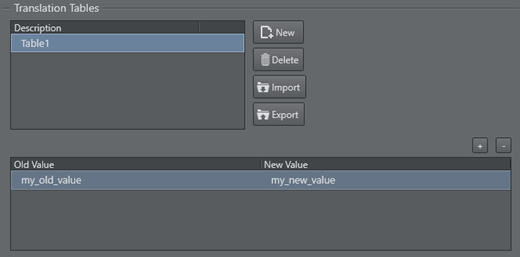
Translation Tables are global for translating values when doing Content Filling. You can have several tables, but only one can be active at any given time. Use New to create a table and add Old and New translations as required. Use Import and Export buttons to load or save translation tables from/to XML-files.
Day Switch Options

-
Activate Day Switch: Activates day switch for split playlists. The default Day-Switch is 04:00 but this can be changed as needed in Channel Settings.
-
Insert Cleanup: Cleans up the program Viz Engine a set amount of time before the day switch takes place.
-
Insert Initialize: Initializes the program Viz Engine a set amount of time before the day switch takes place.
Note: Time is relative to the day switch action inserted, that in itself is inserted as the last element of the day. E.g. the primary event ends 30 minutes after the preferred day switch time then the switch and all other actions are offset by 30 minutes to adjust for this.
Filtering Options
Import Window

The import window defines how much, in time, of the playlist that should be imported at any given time. This is useful in order to control the amount of secondary and, if needed, primary events that should be imported.
-
Import Start Offset: Sets the relative offset for when to start importing elements according to their start time. Format is HH:MM:SS (hours, minutes and seconds). If the current time is 12:30:00 and the start offset is set to 01:00:00 it means only events with a start time set to 11:30:00 and forward will be imported.
-
Import End Offset: Sets the relative offset time for when to end the import. Format is HH:MM:SS (hours, minutes and seconds).
-
Import Primary events outside the Import Window range: Imports the primary elements (groups), but will not try to apply rules or create any secondary elements. This setting should be used in conjunction with the offset settings.
-
Mark partially imported schedule files as .Done: Tags the already processed schedule file as .done such that it is filtered out during next import or update. Files that failed to import are tagged as .fail.
Setting an import interval allows for improved control over what is imported and reduces the overall load on the system.
Some channels may also benefit from setting a small import window in order to set a more frequent Automatic Import Interval - see Automatic Import.
Primary Event Filtering

This section allows you to filter the import process, so that source primary events must meet certain criteria in order to make it into the playlist.
To Create a Primary Event Filter
-
Select your channel.
-
Click the Settings button to open the Settings window.
-
Select Filtering Options.
-
Under the Primary Event Filtering section click the Add Condition icon.
-
Click the Attribute field to select an attribute from the Field Name column.
-
These relate to both the Mapping Settings and the Secondary Mapping Settings.
-
-
Click the Operator field and make a selection (see table below).
-
Click the Value field and enter a time, number or text. Time format is hh:mm:ss:ff.
For a list of operator options, see:
|
Operator |
Description |
|
= |
equal to |
|
> |
greater than |
|
< |
less than |
|
>= |
greater than or equal to |
|
<= |
less than or equal to |
|
<> |
different from |
|
~= |
Contain string (fuzzy search) |
|
!~= |
Does NOT contain string (fuzzy search) |
|
Reg Exp |
A Regular Expression |
Mapping Settings
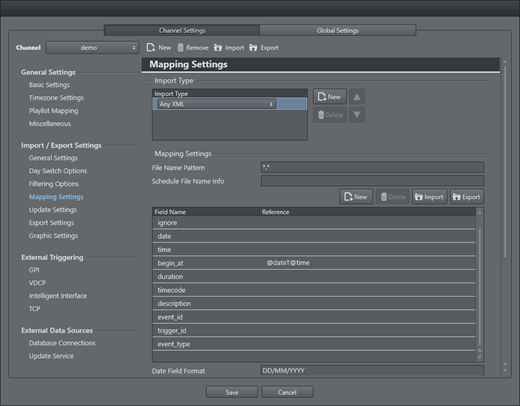
The primary mapping settings can map from scheduling and/or automation systems.
Mapping Settings
-
Import Type: Select the type of external playlist.
-
File name pattern: Enter the specific file format to search for in the import/update folders, e.g. *.xml, *.lst, *10.txt, etc.
-
Schedule File Name Info: When Reading Channel and Date Values from Filenames, indicate the format that Viz Multichannel should expect. The filename must contain the D/M/Y to represent the day, month and year character location in the filename. C must represent the channel name. Note that the occurrences of the letter C are as many times as there are characters in the channel name. X can be used in order to skip characters.
-
Channel10_20100824.txt = CCCCCCCC_YYYYMMDD.
-
20130314_TV2Test.xml = YYYYMMDD_XXXCCCC.
-
Table Columns
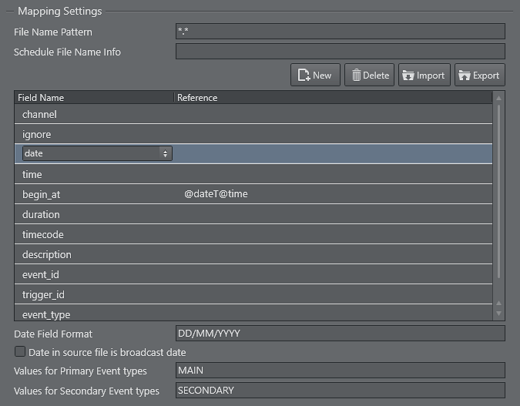
The mapping table is used to add all the rows required to map the source playlist to the Viz Multichannel playlist to be created.
-
Field Name: Is Viz Multichannel’s internal field name. You can either edit the value directly or select values from a drop-down list: click the Field Name entry to show a selectable drop-down list of available Field Name types. For further information, see the Basic Mapping Table Field Names section for information on required and optional field names, and how to use additional field names.
-
Reference: Is the reference to the data in the schedule file. The reference is then mapped to the Field Name. The actual reference code depends on the input data format (textfile, XML etc).
IMPORTANT! Field names and reference values vary depending on the automation system and data formats in use. For further information, see the Import Guide.
-
Date Field Format: This field is optional. If defined, Viz Multichannel will expect to find dates in the source file based on the format provided here.
-
Date in source file is broadcast date: Check this check box if the date in the source file is the same as the broadcast date. Otherwise, leave it unchecked.
-
Values for Primary Event Types: When primary and secondary events are at the same hierarchical level in the source file, indicate the text within the fields that denote primary events. If there is more than one type of denoting text, separate with commas. For example Program,Promo,Commercial. This value will be called from within the event_type field.
-
Values for Secondary Event Types: Indicate the text within the fields that denote secondary events. If there is more than one type of denoting text, separate with commas. For example Logo,Bug. When primary and secondary events are at the same hierarchical level in the source file, the value will be called from within the event_type field. Otherwise, the value will be called from within the seconary_event_type field.
Note: If a field name is empty, duplicate or invalid, the field name(s) in error will be shown with a red border. These field with errors must be corrected.
Primary Events Ignore Settings for Page Content Filling

-
Default behavior: Defines the default behavior during import of primary events for Page Content Filling purposes.
-
When set to FALSE the default behavior is to use all primary events for page content filling except those values listed in the Values field.
-
When set to TRUE the default behavior is not to use all primary events for page content filling except those values listed in the Values field.
-
-
Matches for inverted behavior: Primary events that match the comma separated values will invert the selected default behavior. Note that you need to fill in a reference for the Ignore field name in the mapping table.
Supported wildcards:
-
LIVE- any string that is an exact match “LIVE” is a hit, e.g.: “LIVE”.
-
*LIVE- any string that ends with “LIVE” is a hit, e.g.: “MUSICLIVE”, “NOTLIVE” and “LIVE”.
-
LIVE*- any string that starts with “LIVE” is a hit, e.g.: “LIVESHOW”, “LIVEEVENT” and “LIVE”.
-
*LIVE*- any string that contains “LIVE” is a hit, e.g.: “VERYLIVEMUSIC”, “MUSICLIVE”, “NOTLIVE”, “LIVESHOW”, “LIVEEVENT” and “LIVE”.
LST Import Settings

-
Use Reconcile key as Viz One House Id: After a playlist has been imported, the reconcile keys will be used to set the IDs for the Viz One assets.
-
Get date from schedule file: If the Schedule File Name (see Mapping Settings) is empty, Viz Multichannel will retrieve the schedule date from the ADC-100 system’s RCV file.
-
Code Page: During import, bytes in an LST file, stored in the TITLE field, will be converted according to the defined Windows code page. For example, code page with identifier 1256 will convert bytes to ANSI Arabic.
-
Use Universal Sercom Driver: Enable this when USD is used.
-
Universal Sercom Driver name: If left empty, exports Secondary Events as standard secondary events for Harris. If defined, exports secondary events as macro commands for that Universal Sercom Driver (USD) device for Harris (ID=USD_NAME, Title=VIZRT:Media ID, Reconcile Key=Template_name).
-
Macro Name: Set the macro name used in the Harris system.
Excel Import Settings

-
Header Lines Included: If checked, the header lines will not be read, and reading will start from the first row of data only. If left unchecked, first line will be read. Only relevant if the import type is Excel (*.xls or *.xlsx).
Any Text Import Settings

-
Header Lines in File: Enter the number of header lines in the Any Text file.
-
Skip Lines: Enter the number of lines to skip before beginning to read the import source file for data.
-
Columns Separator: Enter the text symbol (e.g. *) that separates the columns in the text file.
-
File Encoding: Sets the expected file encoding of the imported text file. Alternatives are ANSI, UTF-8, UTF-8 without BOM, and UTF-16.
-
Code Page: Sets the expected code page of the imported text file (e.g. 28591 for ISO 8859-1 Latin 1 or 874 for ISO/IEC 8859-11 Latin/Thai).
XML Import Settings

-
Path of Primary Event Nodes: Path to the element that contains the primary events.
-
Secondary Events Nested in Primary Events: Check this box if secondary events are nested as child elements within primary event nodes.
-
Path of Secondary Event Nodes: Path to the element that contains the secondary events.
-
Channel name is defined at the root level: Assumes that the channel name is defined as a meta data entry (at the root level) outside the primary element entries.
-
Playlist date is defined at the root level: Assumes that the playlist date is defined as a meta data entry (at the root level) outside the primary element entries.
Omnibus Import Settings

-
Code Page: Sets the expected code page of the imported text file (e.g. 28591 for ISO 8859-1 Latin 1 or 874 for ISO/IEC 8859-11 Latin/Thai).
Secondary Mapping Settings
Secondary mapping settings are usually for automation systems for automatic updates. They are used when Viz Multichannel has to read playlists from two different sources. The configuration methodology is the same as described in the Mapping Settings section.
Update Settings
Update Options

-
Automatic Update Mode: Options are:
-
Full: Merging of the playlist as it is in Viz Multichannel with changes that have been made to the original source file.
-
Times: Update of primary event begin time, duration and from changes that have been made to the original source file. Any primary event additions or deletions are ignored. Only the times are updated.
-
Full update without event deletion: Merging of the playlist as it is in Viz Multichannel with changes that have been made to the original source file, without deleting any (primary) elements.
-
-
Delete Processed Files (days old): Enter the number of days after which processed playlist files (*.done) will be deleted.
-
Lock Events from MSE Time: Sets an interval (hh:mm:ss) during which scheduled events will not be updated. The interval starts as of the next update, whether scheduled or manual, and is timed according to the Media Sequencer clock. The default Lock-Time is 00:01:00.
-
Clear played older than (hh:mm): When updating the playlist, Multichannel will remove primary and secondary events which have not been played and are older than the time indicated in this option..
-
Allow updates for a running playlist: When checked, playlists that are currently active will be updated. When unchecked, only playlists that are not playing will be updated.
-
Allow updates of already played Secondary Events: When checked all secondary events will be updated. If unchecked then the secondary events that already have been played will not be updated.
-
If ‘Date’-mapping is blank retrieve date from running playlist: When checked, Viz Multichannel will try to get the date from the running playlist when the “Date”-mapping is blank.
-
Create playlist if one does not exist: If you update a playlist whose date does not exist, Viz Multichannel imports/creates the playlist for you.
-
Send Playlist to remote hosts when import/update playlist: Sends the playlist to remote Media Sequencer hosts (see Remote Hosts).
-
Send Actions to remote host(s): Sends actions to remote Media Sequencer hosts after import or update playlist (see Remote Hosts). If the remote host has an action with the same name, it will skip replacing it. Default value is false.
-
Sync and Transfer pages on each automatic import trigger even when no schedule is imported. Although there is no schedule in the import/update folder, templates and pages are sent to Remote Hosts via the Playlist Importer.
-
Lock edited pages against replacement on updates: self explanatory.
Full Update Options for Secondary Events

These settings are valid both for manual and automatic updates and are checked by default.
-
Get from external playlist: When checked, secondary events will also be updated from source files when performing full updates. When unchecked, they won’t.
-
Reschedule by rules: When checked, secondary events will be updated according to rules (see Working with Rules), when performing full updates. When unchecked, they won’t.
-
Leave manually added items: When checked, secondary events added manually in Viz Multichannel will not be affected, when performing full updates. When unchecked, they will.
Update Times Options for Secondary Events

These settings are valid both for manual and automatic updates.
-
Get from external playlist: When checked, secondary events will also be updated from source files when performing update times. When unchecked, they won’t.
-
Reschedule by rules: When checked, secondary events will be updated according to rules (see Working with Rules), when performing update times. When unchecked, they won’t.
-
Leave manually added items: When checked, secondary events added manually in Viz Multichannel will not be affected, when performing update times. When unchecked, they will.
Export Settings
Export Options

-
Auto Export Folder: Enter the folder path where automatic exports are to be stored.
-
Channel Name in Automation: Enter a channel name that will be recognized by the automation. Viz Multichannel uses this for all export types except XML. If you leave this field blank, the channel name will be the Channel Name in Schedule under the General Settings.
-
Export Secondary Events that do not have offsets: When checked secondary events that do not have offsets are included in the exported file.
Secondary Event ID Assignment

-
Assignment Mode: Generation of IDs for secondary events during export to an LST file. Options are:
-
Automatic: Generates IDs on secondary events that do not have one.
-
Manual: Takes no action.
-
Regenerate: Generates IDs on all secondary events, overwriting existing ones.
-
-
Generate Random ID/Generate Sequential ID: Select Random ID for IDs to be assigned randomly by the system. Select Sequential ID for the numbers to run sequentially from the playlist’s first item onward.
-
Capital Letters (for Random ID): This option is only relevant if you select Random IDs in the previous option. Selecting capital letters will ensure that the letter portion of the generated ID is always in capitals. Otherwise the letters will be a mix of lower and upper case.
-
Prefix Secondary ID: This option is only relevant if you are generating sequential IDs. Enter the string that you want as the ID’s prefix.
-
Initial Secondary ID: This option is only relevant if you are generating sequential IDs. Enter the first number of the ID list.
Harris (LST)

-
Merge Into Existing File: If left unchecked, when you export, Viz Multichannel exports the selected playlist from scratch. If checked, you are prompted to select an existing file, and any new secondary events are added to that file. The resulting file replaces the old one, which is saved as a backup with the extension{{.orig}}.
Graphic Settings

-
Include graphics when sending playlists: When checked, exported playlists will include Viz Multichannel templates converted back into Viz Artist archive files (.via or{{.eva}}). When unchecked, no graphics will be included.
-
*Include graphics data when receiving playlists: *When checked, Viz Multichannel will search for and import playlists along with associated graphics. When unchecked, only the playlist events will be imported.
-
Shared Viz Archive Folder: Enter the folder path to the shared folder where the Channel Name (defined in the General Settings) will get playlists when Sending Playlists to the Master Control.
GPI
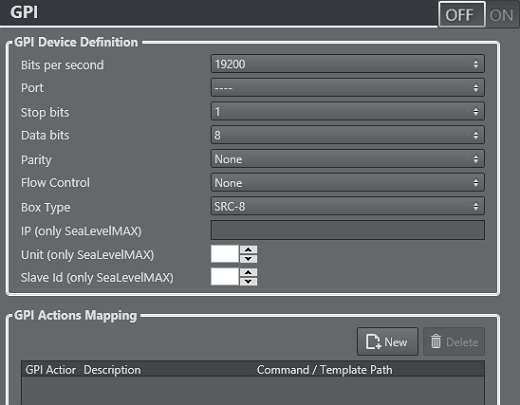
GPI is a type of trigger that does not relate directly to a playlist event. From a list of available commands, you can define what Viz Multichannel will do when it receives any one of them from an external device.
-
Bits per second: Default is 19200.
-
Port: Select the relevant COM port on the Media Sequencer machine. Default is “-
-”. -
Stop bits: Default is 1.
-
Data bits: Default is 8.
-
Parity: Default is None.
-
Box Type: Default is SRC-8.
-
Flow Control: Default is None.
-
Each GPI Action is number DL_n_ or DH_n_, where n is a sequential number, beginning from 0.
-
Under the Commands column, all the Viz Commands, editable templates and general actions such as show logo, remove logo, stop active playlist, etc. are available as options.
-
Description can be defined freely.
-
IP/Unit/Slave Id: only for SeaLevelMAX.
VDCP
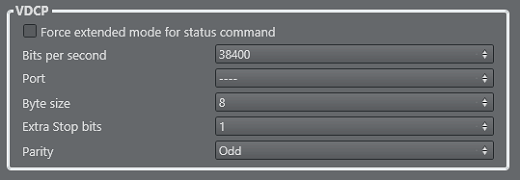
VDCP is one of the protocols that Viz Multichannel uses to communicate with external automation systems. Use UI button switch to ON if using the VDCP protocol, otherwise off.
-
Force extended mode for status command check box: if enabled will include all IDs with length greater than 8 characters in "PORT STATUS REQUEST" and "SYS STATUS REQUEST" VDCP commands.
-
Bits per second: Default is 38400.
-
Port: Select the relevant COM port on the Media Sequencer machine.
-
Byte size: Default is 8.
-
Stop bits: Default is 1.
-
Parity: Default is Odd.
Tip: You can start the Media Sequencer in console-mode to see if VDCP commands are properly sent and received as required when setting up the interface to an automation system. In normal production mode is it recommended to run the Media Sequencer as an automatically started service process.
See Also
-
Media Sequencer documentation regarding vdcp_client_actor.
Intelligent Interface

Intelligent Interface is one of the protocols that Viz Multichannel uses to communicate with external automation systems.
-
Bits per second: Default is 19200.
-
Port: Select the relevant COM port on the Media Sequencer machine.
-
Encoding: Default is UTF-8.
-
Space Means Empty: Default is No.
See Also
-
Media Sequencer documentation regarding Intelligentif actor.
TCP

If you want to receive TCP triggers, you must set a port that the Media Sequencer will listen to for that purpose.
-
Port: Enter the port number. This option is disabled when the field is left empty.
See Also
-
Media Sequencer documentation on pb_listener actor.
Database Connections
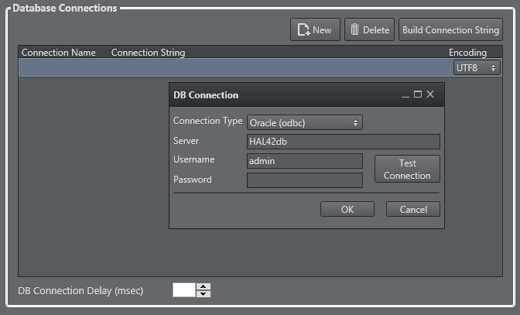
This section describes the Viz Multichannel’s database connections interface, listing all available database connections.
-
New connection (first button): Allows you to manually enter a connection string. Clicking the New connection button adds a new entry to the list of available connections.
-
Delete connection (second button): Deletes the selected connection.
-
Build connection string (third button): Allows you to build a connection string. Clicking the Build connection string button opens a dialog box that allows you to set all parameters needed in order to successfully connect to your source.
Update Service

Update Service is an option that makes use of your own custom web service for page content filling. These Update Service settings are per channel settings. In addition you may define separate update service settings per template.
The Update Service, when configured and enabled on one or more templates, will activate the Media Sequencer to send an XML Payload when a Page is put in pre-queue of being triggered, to a custom web service. This web service can modify the content of the payload and send it back. When MSE receives the payload it will parse it and put the data into the page’s tab field.
The typical use case could for example be for sport-results or latest headlines from a feed. Since it relies on a custom web service the solution can be tailored to be unique. This update service is not an existing server solution, it is a path for external modules to be able to integrate and function with Multichannel and the Media Sequencer.
A timeout of N seconds on the available actions (i.e. take, preview and update) may be set. This is to make sure a reply is given back during the configured timeout (default is 5 seconds) for a given action. If no reply is received within the time-frame the action is not sent/issued, even though a reply is received later.
See Also
